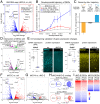Postmitotic accumulation of histone variant H3.3 in new cortical neurons establishes neuronal chromatin, transcriptome, and identity
- PMID: 35930666
- PMCID: PMC9371731
- DOI: 10.1073/pnas.2116956119
Postmitotic accumulation of histone variant H3.3 in new cortical neurons establishes neuronal chromatin, transcriptome, and identity
Abstract
Histone variants, which can be expressed outside of S-phase and deposited DNA synthesis-independently, provide long-term histone replacement in postmitotic cells, including neurons. Beyond replenishment, histone variants also play active roles in gene regulation by modulating chromatin states or enabling nucleosome turnover. Here, we uncover crucial roles for the histone H3 variant H3.3 in neuronal development. We find that newborn cortical excitatory neurons, which have only just completed replication-coupled deposition of canonical H3.1 and H3.2, substantially accumulate H3.3 immediately postmitosis. Codeletion of H3.3-encoding genes H3f3a and H3f3b from newly postmitotic neurons abrogates H3.3 accumulation, markedly alters the histone posttranslational modification landscape, and causes widespread disruptions to the establishment of the neuronal transcriptome. These changes coincide with developmental phenotypes in neuronal identities and axon projections. Thus, preexisting, replication-dependent histones are insufficient for establishing neuronal chromatin and transcriptome; de novo H3.3 is required. Stage-dependent deletion of H3f3a and H3f3b from 1) cycling neural progenitor cells, 2) neurons immediately postmitosis, or 3) several days later, reveals the first postmitotic days to be a critical window for de novo H3.3. After H3.3 accumulation within this developmental window, codeletion of H3f3a and H3f3b does not lead to immediate H3.3 loss, but causes progressive H3.3 depletion over several months without widespread transcriptional disruptions or cellular phenotypes. Our study thus uncovers key developmental roles for de novo H3.3 in establishing neuronal chromatin, transcriptome, identity, and connectivity immediately postmitosis that are distinct from its role in maintaining total histone H3 levels over the neuronal lifespan.
Keywords: cerebral cortex; chromatin; development; histone modification; neuronal identity.
Conflict of interest statement
The authors declare no competing interest.
Figures







Similar articles
-
Contribution of the two genes encoding histone variant h3.3 to viability and fertility in mice.PLoS Genet. 2015 Feb 12;11(2):e1004964. doi: 10.1371/journal.pgen.1004964. eCollection 2015 Feb. PLoS Genet. 2015. PMID: 25675407 Free PMC article.
-
Splitting of H3-H4 tetramers at transcriptionally active genes undergoing dynamic histone exchange.Proc Natl Acad Sci U S A. 2011 Jan 25;108(4):1296-301. doi: 10.1073/pnas.1018308108. Epub 2011 Jan 10. Proc Natl Acad Sci U S A. 2011. PMID: 21220302 Free PMC article.
-
H3-H4 Histone Chaperone Pathways.Annu Rev Genet. 2018 Nov 23;52:109-130. doi: 10.1146/annurev-genet-120417-031547. Epub 2018 Sep 5. Annu Rev Genet. 2018. PMID: 30183406 Review.
-
The histone variant H3.3 marks active chromatin by replication-independent nucleosome assembly.Mol Cell. 2002 Jun;9(6):1191-200. doi: 10.1016/s1097-2765(02)00542-7. Mol Cell. 2002. PMID: 12086617
-
Transcription-coupled H3.3 recycling: A link with chromatin states.Semin Cell Dev Biol. 2023 Feb 15;135:13-23. doi: 10.1016/j.semcdb.2022.05.003. Epub 2022 May 18. Semin Cell Dev Biol. 2023. PMID: 35595602 Review.
Cited by
-
Neuronal DNA double-strand breaks lead to genome structural variations and 3D genome disruption in neurodegeneration.Cell. 2023 Sep 28;186(20):4404-4421.e20. doi: 10.1016/j.cell.2023.08.038. Cell. 2023. PMID: 37774679 Free PMC article.
-
Epigenetics and the timing of neuronal differentiation.Curr Opin Neurobiol. 2024 Dec;89:102915. doi: 10.1016/j.conb.2024.102915. Epub 2024 Sep 14. Curr Opin Neurobiol. 2024. PMID: 39277975 Review.
-
Ash1l loss-of-function results in structural birth defects and altered cortical development.Brain. 2025 Jan 7;148(1):55-68. doi: 10.1093/brain/awae218. Brain. 2025. PMID: 38943682 Free PMC article.
-
Gatad2b, associated with the neurodevelopmental syndrome GAND, plays a critical role in neurodevelopment and cortical patterning.Transl Psychiatry. 2024 Jan 18;14(1):33. doi: 10.1038/s41398-023-02678-x. Transl Psychiatry. 2024. PMID: 38238293 Free PMC article.
-
Reducing methylation of histone 3.3 lysine 4 in the medial ganglionic eminence and hypothalamus recapitulates neurodevelopmental disorder phenotypes.bioRxiv [Preprint]. 2025 May 2:2025.05.02.651761. doi: 10.1101/2025.05.02.651761. bioRxiv. 2025. PMID: 40568105 Free PMC article. Preprint.
References
-
- Venkatesh S., Workman J. L., Histone exchange, chromatin structure and the regulation of transcription. Nat. Rev. Mol. Cell Biol. 16, 178–189 (2015). - PubMed
Publication types
MeSH terms
Substances
Grants and funding
LinkOut - more resources
Full Text Sources
Molecular Biology Databases

